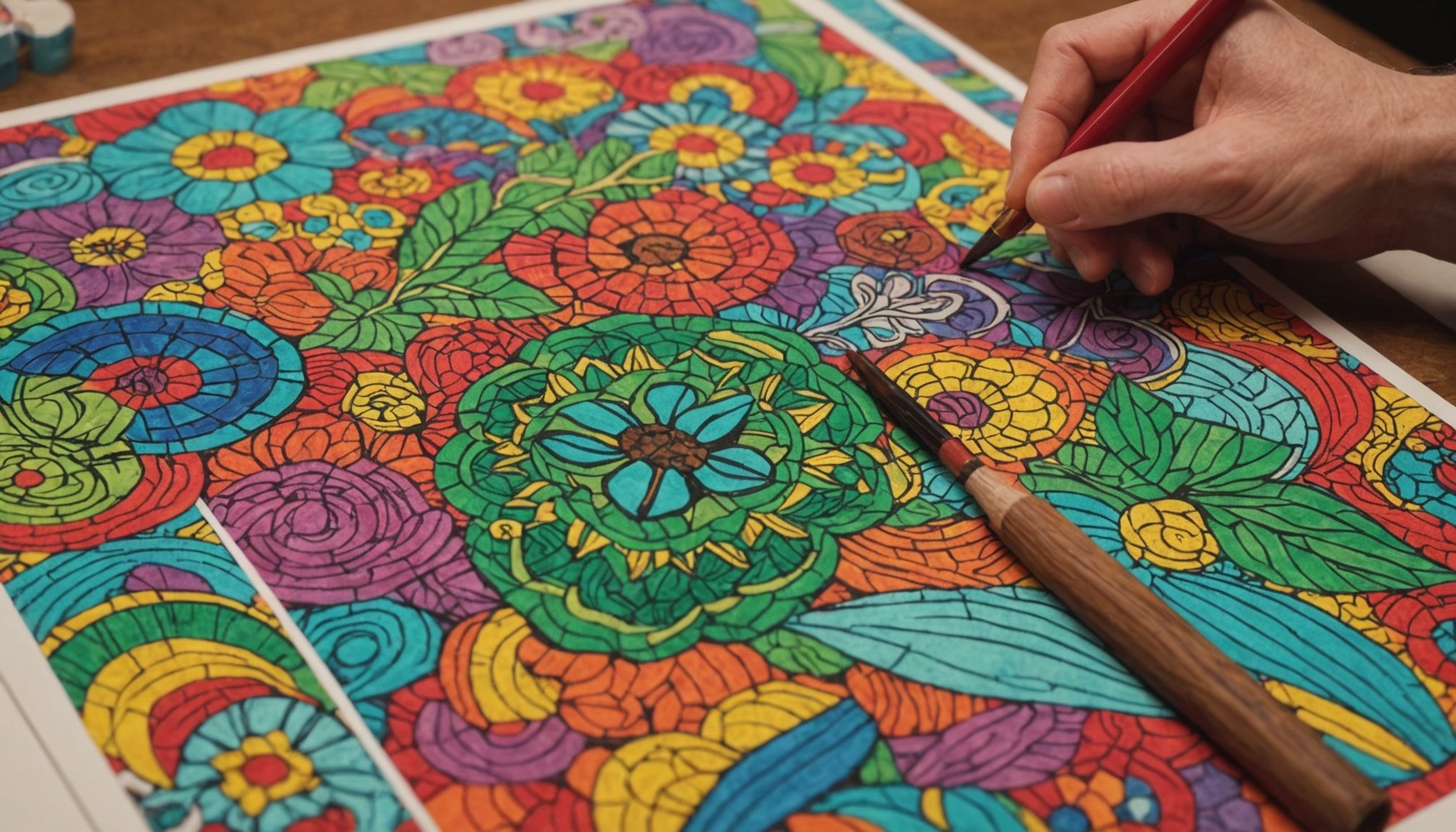Overview of Art Therapy
Art therapy is a form of psychotherapy utilizing creative healing to address emotional and psychological challenges. It involves the use of artistic methods to encourage self-expression, helping individuals process emotions, develop self-awareness, and cope with stress.
Historically, art has served as a medium of expression across many cultures, but the formal practice of art therapy began in the mid-20th century. It evolved as a fusion of art and psychology, spearheaded by pioneers like Margaret Naumburg and Edith Kramer, who explored the relationship between creativity and mental health.
Also read : Revitalize Your Health: The Impact of Weekly Tai Chi on Middle-Aged Wellness
The principles of art therapy revolve around the notion that art enables individuals to express what might be difficult to articulate verbally. The practice encompasses various techniques, including painting, drawing, sculpting, and digital media, allowing a broad spectrum of creative expression. These methods are tailored to meet the therapeutic needs of each individual, fostering a safe space for them to explore their thoughts and feelings.
By engaging in art-making, participants gain insights into their emotional states, using art as a transformative tool for personal growth and healing.
Art Therapy in Addiction Treatment
Integrating art therapy into addiction recovery programs offers a unique pathway to healing. By embracing art-based interventions, these programs provide individuals a platform for self-expression, which is pivotal in addressing deep-seated emotional issues often underlying addiction. Art therapy supports a non-verbal mode of communication, which can be crucial for those struggling to articulate their experiences and emotions.
One significant advantage of art therapy is its ability to reduce relapse rates. By engaging in creative processes, individuals gain insights into their motivations and behaviours, fostering a deeper understanding necessary for sustainable recovery. Creative expression can also serve as a coping mechanism, allowing patients to channel negative feelings into tangible artwork rather than returning to substance use.
When compared to traditional therapy methods, art therapy stands out for its inclusivity and adaptability. While conventional talking therapies focus on dialogue, art therapy transcends linguistic boundaries, making it accessible to those who may find verbal expression challenging. Furthermore, therapeutic techniques in art therapy are versatile, accommodating a wide range of artistic activities like painting, drawing, or sculpting, thus catering to diverse interests and preferences.
Benefits of Art Therapy for Individuals in Recovery
Art therapy offers numerous advantages for individuals undergoing addiction recovery, emphasizing emotional healing and mental health benefits. Engaging in creative processes allows participants to experience significant stress reduction and improved emotional regulation. Art therapy provides a non-verbal outlet for feelings, which helps participants to manage intense emotions constructively.
One of the core benefits is the enhancement of self-esteem and confidence. Through artistic expression, individuals gain a sense of accomplishment and personal growth, which is vital during recovery. This positive reinforcement continually encourages them to pursue healthier lifestyles and resist relapse.
Community-building is another significant aspect of art therapy. The shared experience of creating art fosters connections among participants, providing a supportive network that aids in recovery. These interactions promote understanding and cooperation, establishing a sense of belonging which is crucial for overcoming addiction.
Art therapy has proven to be a transformative tool within recovery processes by empowering individuals to express themselves, harness creative healing, and cultivate meaningful connections. Each of these benefits collaborates to support a holistic approach to recovery, emphasizing the importance of mental well-being in the journey to sobriety.
Personal Stories and Case Studies
Art therapy’s transformative potential in addiction recovery is vividly illustrated through personal stories and case studies. These real-life experiences showcase how creative expression can catalyse profound change in individuals battling addiction.
One compelling success story is that of John, a former addict who turned to art therapy during his recovery journey. Through painting and drawing, John found a new way to articulate feelings he couldn’t express in words, revealing the depth of his emotional struggles. This self-exploration through art provided a much-needed outlet and contributed significantly to his sobriety.
Case studies corroborate these individual stories, systematically demonstrating art therapy’s effectiveness. A notable study conducted in a rehabilitation centre showed a 30% increase in emotional regulation and a significant reduction in relapse incidents among participants engaging with art-based interventions.
Participants often reflect on their healing processes, highlighting how artistic activities foster a deeper understanding of their thoughts and emotions. These accounts underscore the therapeutic value of art therapy, reinforcing its role as a potent tool in not only treating addiction but also enriching the overall journey of personal growth and recovery.
Supporting Statistics on Art Therapy Efficacy
Art therapy is a compelling intervention in the realm of addiction recovery, and research findings provide solid evidence of its effectiveness. Numerous studies demonstrate significant therapeutic outcomes linked to art therapy’s integration into treatment programs. Statistical analysis reveals that individuals who engage in art-based interventions often experience enhanced emotional regulation and stress reduction.
One key study highlighted a 30% improvement in recovery rates among participants using art therapy compared to those relying solely on traditional methods. This underscores art therapy’s role in fostering emotional resilience and lowering relapse rates. Experts unanimously advocate incorporating art therapy into addiction treatment, citing its unique ability to facilitate self-expression and emotional catharsis as pivotal.
Moreover, the data reflected in recovery statistics suggest an increased sense of self-awareness and personal growth among participants. The therapeutic outcomes of these programs are further bolstered by expert opinions, which emphasise the value of creative expression as a pathway to emotional healing. As more research is conducted, the growing body of evidence continues to validate the positive impact of art therapy on addiction recovery, reinforcing its status as an essential component of holistic treatment strategies.
Practical Tips for Incorporating Art Therapy into Recovery Programs
Integrating art therapy into recovery programs involves thoughtful planning and understanding of its potent benefits. Starting with guidelines for introducing this therapeutic approach, it’s essential to create a welcoming environment that encourages openness. Ensuring that art therapy sessions are led by qualified art therapists is crucial. These professionals are skilled at facilitating expressive techniques tailored to each individual’s needs.
Effective activities and exercises include painting, sculpting, and digital media arts, promoting self-exploration and emotional healing. It’s beneficial to vary these activities and allow individuals to choose, fostering a sense of autonomy and personal investment. Encouraging group sessions can also enhance the communal aspect, enabling participants to share experiences and build support networks.
Providing access to resources such as materials and dedicated spaces further enriches the recovery experience. For those seeking qualified art therapists, connecting with reputable organizations or local mental health services can be invaluable. Overall, the practical application of art therapy can significantly enhance the recovery process, empowering individuals to express themselves, gain insights, and develop robust coping strategies.
Psychological and Emotional Aspects of Healing through Creativity
Creative healing significantly impacts the psychological and emotional well-being of individuals, particularly in addiction recovery. Engaging in artistic expression provides an emotional release, essential for processing complex emotions that may be challenging to verbalize. This non-verbal outlet helps individuals articulate feelings constructively, playing a crucial role in their overall psychological healing.
Art therapy facilitates the development of coping mechanisms by transforming negative emotions into creative outputs. These processes promote self-reflection and insight, enabling individuals to navigate emotional challenges with greater resilience. For many, the repetitive nature of art-making offers a meditative quality, fostering relaxation and stress reduction.
Moreover, participation in creative activities reinforces the foundation for emotional growth and stability. It aids in the regulation of strong emotions, providing a sense of control and empowerment. As individuals progress through their recovery journey, the skills developed through art therapy can be harnessed to maintain long-term sobriety and enhance functional coping strategies.
The transformative journey achieved through art-making is not merely about confronting difficulties but also celebrating personal progress and achievement. This dynamic interplay between creativity and healing constructs a robust framework for recovery and emotional well-being.
Expert Insights on Art Therapy and Addiction Recovery
Professional perspectives on art therapy’s role in addiction recovery are invaluable, providing insights into its effectiveness and evolution. Certified art therapists emphasize the modality’s ability to facilitate self-expression, a crucial component in addressing emotional wounds. According to these experts, art therapy allows individuals to externalize experiences that are difficult to verbalize, fostering a therapeutic environment where healing flourishes.
Interviews with therapists reveal practical advice, highlighting the importance of tailored approaches. Each participant’s unique needs guide the selection of art forms, whether it be painting, sculpture, or digital media. This customization supports deeper connection and personal investment in recovery.
Expert advice advocates for integrating group sessions within art therapy programs, enhancing communal support and shared experiences. This collaborative aspect not only strengthens ties between participants but also enriches personal insight.
Looking to the future, professionals foresee trends emphasizing technology’s role in art therapy. Digital platforms for art creation and virtual sessions extend access, making therapy more inclusive. Furthermore, ongoing research will continue to sharpen best practices, ensuring that art therapy remains a pivotal, adaptive component of addiction recovery strategies.

